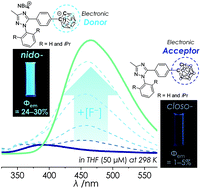Impact of deboronation on the electronic characteristics of closo-o-carborane: intriguing photophysical changes in triazole-appended carboranyl luminophores†
Abstract
5-Phenyl-1,2,4-triazole-appended closo- (CB1 and CB2) and nido-o-carboranyl (nido-CB1 and nido-CB2) compounds were prepared and fully characterized using multinuclear NMR spectroscopy and elemental analysis. The solid-state molecular structures of both closo-compounds were analyzed by X-ray crystallography. Although the closo-compounds exhibited dual emissive patterns in the rigid state (in THF at 77 K), which were assignable to a π–π* local excitation (LE)-based emission (λem = ca. 380 nm) on the triazole moieties and to an intramolecular charge transfer (ICT)-based emission (ca. 460 nm) in which the o-carborane units acted as the acceptor (A), at 298 K in THF, the LE-based emission dominated. In contrast, the nido-compounds exhibited an intensive emission originating from ICT transitions in which the o-carborane units reversibly acted as the donor (D). In particular, the positive solvatochromic effects of both nido-compounds and the results of theoretical calculations for the o-carboranyl compounds supported the electronic role of the o-carboranyl unit in each compound. Investigation of the radiative decay mechanism of the closo- and nido-compounds using their quantum efficiency (Φem) and decay lifetime (τobs) suggested that the ICT-based radiative decay of nido-compounds occurred more efficiently than the LE-based decay of closo-compounds. These results implied that emission from the closo-compounds was drastically enhanced by the deboronation reaction upon exposure to an increasing concentration of fluoride anions, and finally became similar to the emission color (sky-blue) of the nido-compounds.



 Please wait while we load your content...
Please wait while we load your content...